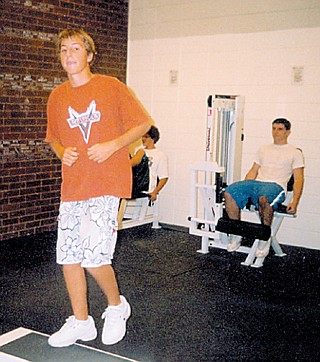October 9, 2003 at 11:09 a.m.
Sound too good to be true? It really is not. What’s happening is the district qualified for a National School Fitness Foundation (NSFF) grant that’s supporting a huge study on childhood obesity. The schools receiving the grant basically run a physiological research and data gathering protocol in return for the equipment.
The L.I.F.T. grant was secured through the efforts of High School Principal Dave Ertl, district administration and the phy ed department, along with cooperation from sports and activities personnel.
Workout machines in the new weightroom by the Performing Arts Center were relocated to the old weight room and/or some pieces were put out for public bid. The grant specified the type of flooring needed in the exercise area and number of electric outlets, and that’s all the district supplied. The fitness foundation units (aerobic steppers, stationary bikes, weight machines and the body fat analysis computers) were delivered and installed in the weight room by the start of this school year.
Phy Ed Department Director Darla Fehlandt pointed out that the grant also supplied the high school with a heart rate monitor, it paid for specialized training to run the program and a de-fibrillator. The first aid components of the L.I.F.T. equipment alone came to over $4,000.
Fehlandt couldn’t speak highly enough of the program.
She thinks the kids are showing “a lot of enthusiasm” just a short time into it. Not only will the students get the health benefits of the workouts, they will also learn more about body composition and get a practical lesson in the fact that outward appearances don’t necessarily mean someone is or isn’t in shape.
Herb Jangor, phy ed instructor and a Chisago Lakes varsity coach, also said the students seem to be getting into the program.
“We play music and keep things moving and mix it up with other things like swimming and gym activities,” he said, explaining how the grant was worked into curriculum this year.
Jangor said he’s excited for the “non-athlete” --the kids who obviously don’t get much rigorous activity. “They’ll see themselves get stronger and more fit and it’ll be really good for them, they’ll feel better.”
He’s anxious to track the results at mid-term. Kids will see their ability to lift a certain number of pounds is up, body fat is reduced, their heart rates have improved and step-test results are better.
Students in this study are in grades 9 and 10. There are about 100 students per semester participating. The program under the obesity study is required to be nine weeks long and run 26 minutes each session.
Fehlandt said the study is developed on the lines of working opposing muscle groups. She said heart rates are monitored (resting and recovery) and each student is observed and measured for their vital measurements. So-- if one student may not be moving as swiftly as another; if they are working within their heart rate they are where they should be, she noted.
The data gathering also requires tracking body fat, blood pressure and flexibility.
The data is the reason the district gets the equipment. As long as the study is adhered to (three year commitment) the district spends nothing on the equipment.
Heide Miller, Business Services Director, said the non-profit status of the foundation requires the district to “deposit” a monthly payment in a Wells Fargo-secured account, but the deposit is immediately reimbursed by the grantors. The monthly “lease” is $6,400 or a total over three years of $215,000. Upon receiving proof the check is in the account, the foundation reimburses the district, Miller said. All interest and principal are covered.
The School Board voted to authorize Miller and Ertl to sign contracts and approved a resolution allowing the district to lease the equipment a few months ago.





Comments:
Commenting has been disabled for this item.